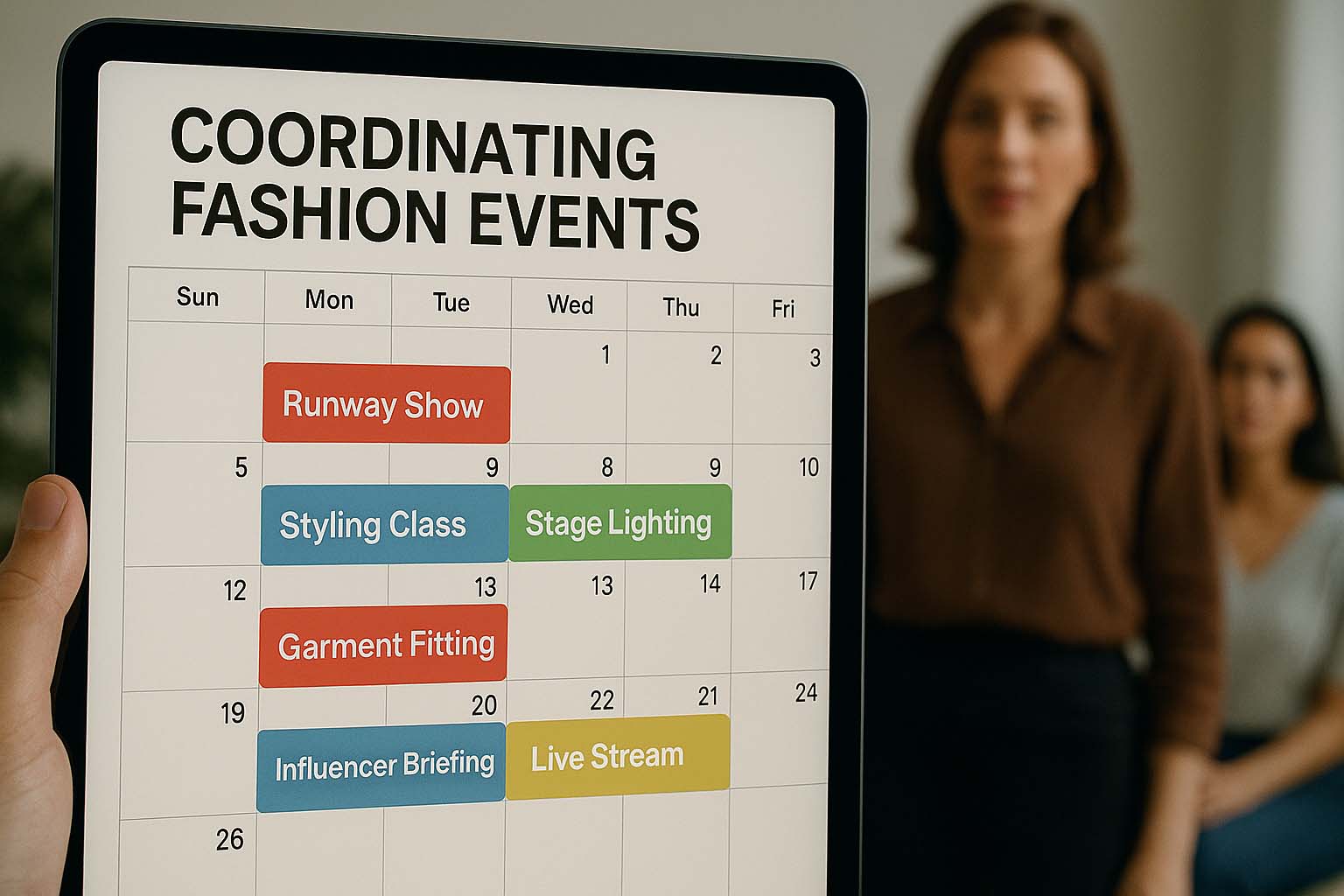Coordinating Fashion Events with Digital Calendars
Why Careful Scheduling Matters
Behind every successful fashion happening—from grand runway shows to intimate styling classes—lies a solid planning framework. Speed of communication and coordination is critical, and professionals now open a smart device each morning to scan the board of today’s events. Manual notes in a paper planner no longer meet the pace required when schedules shift by the hour across continents and multiple zones. For stylists, producers, and brand managers, a single scheduling slip can waste thousands of dollars, damage reputations, or misinform guests. A digital calendar is no longer a luxury; it is the backbone of modern event organization, reminding teams when to fit garments, light stages, brief influencers, and cue the live stream in perfect sequence.
Quick Overview
- Digital calendars provide a clear view of timelines, essential for fashion gatherings.
- They prevent double bookings, overlapping tasks, and unexpected conflicts.
- Shared access gives teams real-time updates and faster coordination.
- This article explains how to use calendar apps effectively for global fashion engagements.
Preparing with the Right Tools
Paper and pencil have their charm, yet modern logistics demand updated methods. Leading production houses rely on applications such as Google Calendar, Apple Calendar, and event-specific platforms including Asana, Trello, and Notion. Every step—initial concept meeting, fitting schedule, logistics run, media invitation, and venue walkthrough—can be tagged, color-coded, and set with reminders. Stress drops as the event day approaches because everyone sees the same timeline.
Attachment features add depth. Designers can link look-book PDFs to the fitting slot, while lighting experts attach rig diagrams to setup blocks. Organizers working on the move receive push alerts on phones and smartwatches, ensuring they never miss a change.
Imagine a showcase featuring three brands. A shared calendar assigns the fitting slot for Brand A, rehearsal for Brand B, and media arrival for Brand C. At a glance, all teams grasp the flow of the day.
Stronger Team Coordination
A single event might involve designers, stylists, models, makeup artists, logistics crews, and public relations staff. Each role carries its own timetable that must align for smooth execution. A team-wide calendar displays deadlines, rehearsal blocks, briefing calls, and guest-list cut-offs in one place. This transparency boosts cooperation and lowers the odds of confusion.
Clear visual cues make a huge impact. Color tags help workers scan for their area—green for wardrobe, blue for stage, red for press. They no longer dig through endless email threads looking for their next task.
Many platforms also connect calendars to communication hubs such as Slack or Microsoft Teams, and every update appears instantly in the group chat. People stay informed without digging through separate threads.
Managing Venue and Logistics
Booking a venue, setting up lights, inspecting sound, and receiving equipment often slip through cracks when schedules are scattered. A digital calendar holds all these details—supplier arrival, rigging time, and cleanup window—in one timeline.
International programs add complexity. Time-zone differences affect video calls, freight arrivals, and VIP greetings. Modern tools display multiple zones side by side, helping planners avoid accidental midnight meetings or late shipments.
Extra padding in the schedule guards against customs delays or weather-related freight holdups. By marking buffer hours directly on the timeline, planners keep the show on track even when external factors interfere.
Clear Communication with Clients and Partners
Organizers must also sync with external contributors—brands, journalists, sponsors, and special guests—each with unique availability. Sending calendar-ready invitations shows respect for their time and keeps everyone aligned.
Services like Calendly simplify appointment setting without endless email loops. Once integrated, each confirmed slot drops directly into the master schedule, removing manual data entry.
Including agenda notes inside invitations improves preparation. A buyer knows which collection to review during a showroom visit, while a blogger arrives with interview questions ready, smoothing press coverage.
Reminders and Notifications
With countless moving parts, forgetting a task is easy. Automated reminders solve that risk. Planners can request alerts a week before a fitting, a day before dress rehearsal, or even minutes before a livestream.
Recurring events help routine meetings appear automatically. Weekly creative huddles or monthly production reviews no longer need manual encoding, saving hours over a season.
Push alerts on mobile devices keep coordinators aware of last-minute tweaks even while guiding models, adjusting lights, or greeting sponsors and seated guests.
Escalation chains ensure critical alarms never stay unnoticed. If the first recipient ignores a reminder, the system forwards it to a backup contact, preserving accountability.
Real-Time Adjustments and Contingency Handling
Unexpected delays occur—catering runs late, traffic blocks the venue entrance, or a model faces an emergency. Live calendar updates keep the team agile. Instead of calling everyone, an organizer edits the timeline and adds a note. Sync features push alerts to each member instantly.
If rehearsal moves from three to five in the afternoon, one change in the calendar informs every stakeholder, protecting valuable minutes.
The same approach helps during technical mishaps. Sound checks that overrun can be logged immediately, pushing back guest seating without raising panic. That flexibility, when embraced by every department, keeps energy high and preserves the polished atmosphere expected at premiere fashion platforms worldwide today.
Better Documentation for Future Events
Detailed calendar history reveals which tasks finished on time, which sections lagged, and where stress peaked. That record guides better budgeting, staffing, and client communication for upcoming projects.
Analysts can export event timelines into spreadsheets, correlate them with sales data, and see whether schedule shifts impact revenue at merchandise booths or online streams.
Post-event debrief sessions become richer when each timeline detail is visible. Team members annotate the calendar with reflections such as “hair crew needed fifteen minutes extra” or “VIP arrival stirred congestion.” These notes transform raw dates into actionable learning material.
Blending Calendars with Visual Planning Boards
For a more graphic approach, many organizers pair Trello or Notion boards with their calendars. Task cards show progress, and linked due dates appear inside the shared schedule. A stylist working on the “final fitting checklist,” for example, sees the same deadline both in the board and the calendar. This harmony smooths the creative process and aligns design goals with logistics.
Gantt-style extensions reveal duration blocks, allowing producers to spot overloaded days early. Rebalancing tasks becomes a drag-and-drop exercise rather than a series of tense calls.
Advantages of Digital Scheduling
Digital calendars do more than organize—they raise the overall standard of fashion events worldwide. Key benefits include:
- Fewer conflicts between tasks
- Better team communication
- Higher client satisfaction through clear coordination
- Stronger time management
- A polished impression for media and stakeholders
The focus is not technology itself but the respect for time, process, and detail at every stage—from concept to catwalk. Consistent structure builds confidence among clients and encourages sponsors to return season after season.
The Backbone of Outstanding Fashion Events
A digital calendar is more than a tool; it is the pillar that upholds seamless planning. In a scene celebrated for visual brilliance, unseen systems of timing, people, and preparation make the glamour possible. When schedules flow smoothly, teams devote energy to aesthetics rather than logistics, certain that the event will run as designed.
Such order creates experiences that are not only memorable but also inspiring across the industry. In an age where each detail carries weight, precise timing has become the standard rather than an extra. Start with a simple step—set up a reliable digital calendar—and watch each element of your next show become sharper, more unified, and ultimately more successful.


